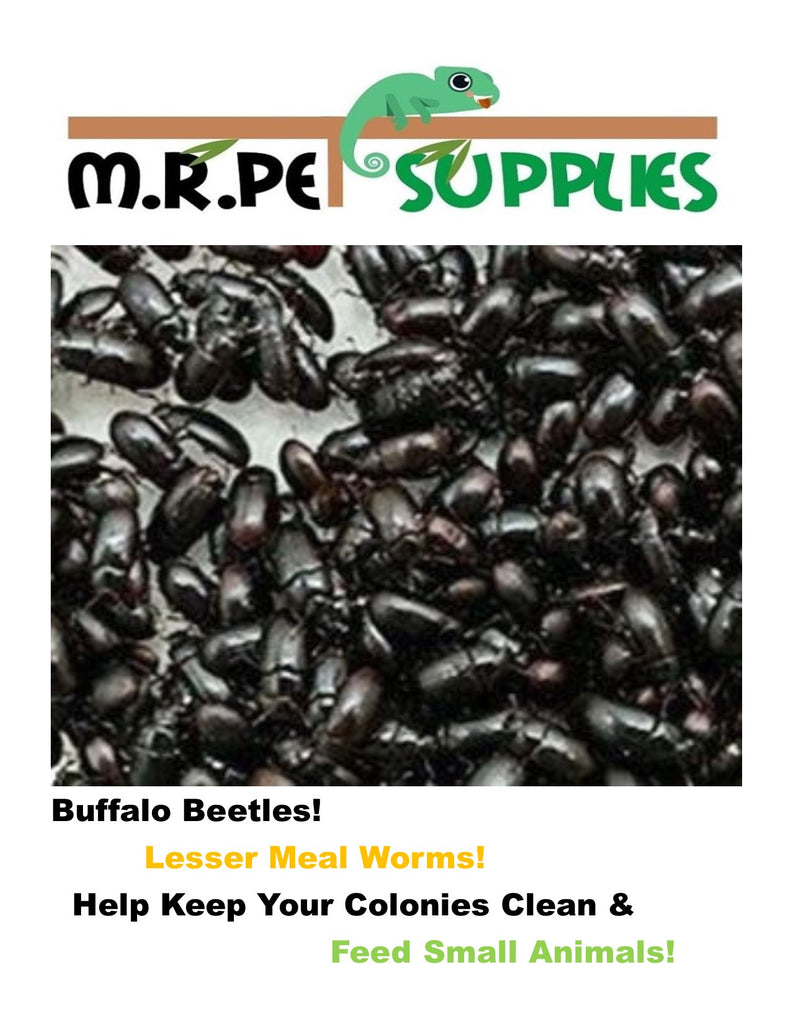PoundPuppy
New Member
Should I be worried ? And if so how do I get rid of them ?

 mrpetsupplies.com
mrpetsupplies.com
My one tortoise had passed away and they had entered the rectum and started eating him from the inside out and now I found some in my remaining tort enclosure and then I became worried that the beetles killed the other tort vs just eating a dead animalLike micro-mealworm buffalo beetles?

Cleaner Crew - Buffalo Beetle - Lesser Mealworm
The Buffalo beetle or lesser mealworm is a fantastic addition to many bio-active or insect feeder colonies; Scientific name Alphitobius diaperinus. Buffalo worm larvae and the beetles eat the dead, help fight mold, fungi, mites, flies and smell. They can live side by side with many insects, most...mrpetsupplies.com
They won't harm your tort.
Most tort species won't eat them, however. Which is too bad - they're pretty nutritious. Russians might - they have been caught hunting and eating insects.
Once they settle in they are prolific and eat all sorts of things, so you probably don't want a colony in your enclosure.
I did a bark , stone , soil combo for their indoor enclosures all the repti zoo brand minus the rocks I got from Home Depot but I boiled them in water and soaked them overnight before adding them I suspect they came in through one of them I never see them until I go to remove whatever left over is in there at night as soon as I lift it they start burrowing in I grab handfuls and toss them out but there seems to always be moreIf there are enough insects to eat a tortoise, then the colony has been in the enclosure for quite some time.
Tortoises are locked into their shells...unlike animals that can groom an injury or otherwise remove a parasite that bites them, a sick or injured tortoise would be outright victimized by an opportunistic insect (flies, beetles, etc.).
If your tortoise passed quietly during a cold time of year (cool-down and brumation are very high-risk experiences for all reptiles), then beetles and larvae would be doing their job of cleaning up the environment.
And I guess it would be possible for an over-run infestation to turn on an otherwise healthy animal in winter slow-down and cause fatal damage in a short amount of time.
So the question would be how did these beetles get into the enclosure and set up a breeding colony of such a size?
So they eat decomposing meat. Why would they attack live meat? That's 2 way different habitsIf there are enough insects to eat a tortoise, then the colony has been in the enclosure for quite some time.
Tortoises are locked into their shells...unlike animals that can groom an injury or otherwise remove a parasite that bites them, a sick or injured tortoise would be outright victimized by an opportunistic insect (flies, beetles, etc.).
If your tortoise passed quietly during a cold time of year (cool-down and brumation are very high-risk experiences for all reptiles), then beetles and larvae would be doing their job of cleaning up the environment.
And I guess it would be possible for an over-run infestation to turn on an otherwise healthy animal in winter slow-down and cause fatal damage in a short amount of time.
So the question would be how did these beetles get into the enclosure and set up a breeding colony of such a size?
So they eat decomposing meat. Why would they attack live meat? That's 2 way different habits
Thanks for the explanation. That's how we learnI don't really think that's what happened here. But Buffalo beetles are opportunistic generalists. They eat vegetation, fruit, grain, meat, scat, mold, dander...any biological matter subject to decay. Like fly maggots, they can certainly take advantage of a poor-doing live organism.
A species like a tortoise that cannot turn to groom, in a cold, overrun enclosure could put you in a situation where an animal is too dull to even move around trying to escape them...then larvae may invade the vent following the scent of scat. In a properly heated enclosure, an animal may succumb to stress from unsuccessfully fleeing a giant infestation, or die from other causes...then the remains are likewise easy to invade.
If the substrate is literally handfuls of bugs, this infestation did not just happen.
They can be carried on an egg-infested commercial food pellet. But Buffalo beetles are also universal - they naturally occur all over the world. They are kept as feeder insects, so substantial captive colonies are present in neighborhoods. Adults have been known to fly when seeking new food sources.
OP: the only way to remove the insect colony is to discard all of the substrate, any containers of packaged food pellets; thoroughly clean any pet enclosures to remove any eggs. Vacuum daily...there are probably larvae in the house, especially if you have carpet. Carefully treat the house with a flea product that contains a Growth Regulator Hormone (Precor is a popular one - ask at your local garden shop, and follow all the product safety instructions). If you leave a colony in its enclosure, your other tort is not going to feel or live well.